Bloom of filamentous bacteria in a mesotrophic lake: identity and potential controlling mechanism
- PMID: 15466575
- PMCID: PMC522086
- DOI: 10.1128/AEM.70.10.6272-6281.2004
Bloom of filamentous bacteria in a mesotrophic lake: identity and potential controlling mechanism
Abstract
Ephemeral blooms of filamentous bacteria are a common phenomenon in the water column of oligo- to mesotrophic lakes. It is assumed that the appearance of such morphotypes is favored by selective predation of bacterivorous protists and that filter-feeding zooplankton plays a major role in suppressing these bacteria. The phylogenetic affiliation of the important bloom-forming filamentous bacteria in freshwaters is presently unknown. Here we report the identification of dominant members of a filamentous bacterial assemblage during a bloom of such morphotypes in a mesotrophic lake. By molecular cloning and fluorescence in situ hybridization with specific oligonucleotide probes, up to 98% of filamentous cells in lake water could be assigned to a clade of almost identical (99% similarity) 16S rRNA gene sequence types, the cosmopolitan freshwater LD2 cluster. For a period of less than 1 week, members of the LD2 clade constituted >40% of the total bacterial biomass, potentially favored by high grazing of planktivorous protists. This is probably the most pronounced case of dominance by a single bacterioplankton species ever observed in natural freshwaters. In enclosures artificially stocked with the metazoan filter feeder Daphnia, bacteria related to the LD2 clade formed a significantly larger fraction of filaments than in enclosures where Daphnia had been removed. However, in the presence of higher numbers of Daphnia individuals, the LD2 bacteria, like other filaments, were eventually eliminated both in enclosures and in the lake. This points at the potential importance of filter-feeding zooplankton in controlling the occurrence and species composition of filamentous bacterial morphotypes in freshwater plankton.
Figures
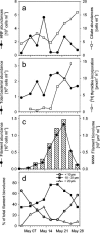


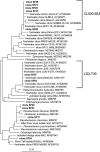
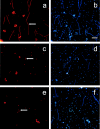
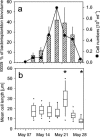
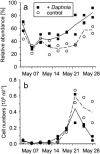
References
-
- Bell, R. T. 1993. Estimating production of heterotrophic bacterioplankton via incorporation of tritiated thymidine, p. 495-503. In P. Kemp, B. F. Sherr, E. B. Sherr, and J. Cole (ed.), Handbook of methods in aquatic microbial ecology. Lewis, Boca Raton, Fla.
-
- Bianchi, M. 1989. Unusual bloom of star-like prosthecate bacteria and filaments as a consequence of grazing pressure. Microb. Ecol. 17:137-141. - PubMed
-
- Brendelberger, H. 1991. Filter mesh size of cladocerans predicts retention efficiency for bacteria. Limnol. Oceanogr. 36:884-894.
-
- Daims, H., A. Bruhl, R. Amann, K. H. Schleifer, and M. Wagner. 1999. The domain-specific probe EUB338 is insufficient for the detection of all bacteria: development and evaluation of a more comprehensive probe set. Syst. Appl. Microbiol. 22:434-444. - PubMed
Publication types
MeSH terms
Substances
Associated data
- Actions
- Actions
- Actions
- Actions
- Actions
- Actions
- Actions
- Actions
- Actions
- Actions
- Actions
- Actions
LinkOut - more resources
Full Text Sources
Molecular Biology Databases

